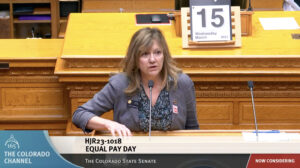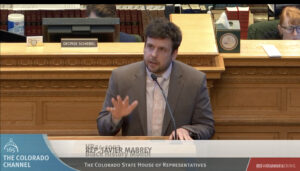A storied part of Colorado’s history, railroads continue to serve as key infrastructure for its present too, hauling durable goods, consumer items and oil and gas. And that is why business leaders are concerned by a bill to impose new regulations on railroad operators.
House Bill 1030, which passed the House early this month and is scheduled for a key vote Wednesday in its first Senate committee, is a bill to boost railroad safety in the wake of a slew of high-profile accidents, its proponents say. Sector leaders counter, however, that after years of achieving record safety marks, they believe it’s an unnecessary effort to impose further regulations and give more power over rail operations to union workers.
The bill, sponsored by Democratic Reps. Javier Mabrey of Denver and Tisha Mauro of Pueblo, sprang from meetings that the Transportation Legislative Review Committee held after the 2023 session, in which unionized rail workers said they needed more protections. Specifically, many said both then and in testimony this session, they worried that longer trains are leading to more accidents and derailments, and they wanted to give the state more power to prevent mishaps and workers more power to investigate them.
What the railroad regulations would do
HB 1030 first and foremost would limit trains operating in Colorado to no more than 8,500 feet in length, making this the first state to impose such a rule as an effort to limit trains to 7,500 feet in length appears stalled at the federal level. Railroad leaders have expressed skepticism over whether a state can impose rules like this on a federally regulated industry replete with interstate travel, but bill sponsors have said repeatedly that they can do so.
The bill also would make railroads install wayside detectors, which monitor for hot bearings or dragging items, every 10 miles and minimize obstructions of roadway crossings by stopped trains, particularly by separating trains upon the approach of emergency vehicles. It would make the Public Utilities Commission set new minimum insurance requirements for railroads, give the PUC the ability to impose fines as high as $100,000 per violation and allow union representatives to investigate sites where injuries, deaths and violations occur.

Colorado state Sen. Lisa Cutter speaks on the Senate floor during the 2023 legislative session.
At a Senate Transportation and Energy Committee hearing on Wednesday, cosponsoring Sen. Lisa Cutter, D-Morrison, cited numerous local and national incidents from the past year, including a fiery derailment in Ohio and a deadly accident in Pueblo. With rail continuing to be a big part of the Colorado economy and environmental groups citing it as a greener way to move people and goods, it’s imperative the state boost protections for workers, passengers and areas near rail lines, she and other backers said.
“The safety of our community is of the utmost importance,” said Carl Smith, Colorado state legislative director for the International Association of Sheet Metal, Air, Rail and Transportation Workers. “By passing this bill in its entirety, Colorado will lead the nation.”
Needed safety or regulatory overreach?
Industry leaders say, however, that rail operations could become among the most expensive in the nation because of the added costs of regulations imposed when overall safety already is improving, despite several notable accidents. And at a time when inflation and other factors already have created an affordability crisis in housing and other areas for everyday Coloradans, those costs will trickle down into rising prices for everything from food to gas that consumers buy after it’s transported by trains, they said.
David Ohara, general director of operating practices for Union Pacific, told the Senate committee that his railroad recorded record lows in safety violations in 2023 as it continues to boost training for workers. It also has the ability to alert emergency dispatchers to incidents that may block railroad crossings, so they can find alternate routes, he said.
Forcing trains to be broken into smaller units when entering this state could make it less efficient and more expensive to operate, railroad leaders have said. And the size of fines and pending insurance requirements — which HB 1030 would require PUC to determine by November — could be financial problems for the companies, said Mike Ogborn, a senior advisor at the American Short Line & Regional Railroad Association.
“For our members, that type of coverage that’s called for in the bill is simply not available,” Ogborn said of the prescribed insurance coverage for hazardous-material transporters that must be adequate to cover costs and liabilities resulting from accidents.

Colorado state Rep. Javier Mabrey speaks earlier this session on the House floor.
Railroad trains are growing
Paul Pearson, chairman of the Colorado state legislative board of the Brotherhood of Locomotive Engineers and Trainmen, said trains formerly averaged 4,000 to 7,500 feet in length, though it now is not uncommon to see trains of 10,600 feet. While Pearson said that operating trains that are two miles long makes it difficult for other trains to pass and causes crossing blockings when trains must pull off the main tracks, other railroad leaders said there is no proven connection between train lengths and safety.
House sponsors made several changes to conform to federal law and to deal with some of the biggest concerns of the railroads.
They, for example, removed a provision that would have allowed union representatives to enter a railroad’s place of operations to investigate accident reports, scaling it back so they could just be on accident sites. And they cut a proposed requirement for trains to not obstruct crossings for more than 10 minutes, acknowledging that the federal government regulates crossings as they changed language to require railroads to “immediately take any action” to clear the crossings.
Still, the level of detail in the requirements remaining in the bill will be an operational and cost burden with no added safety benefits, railroad leaders said. Adrian Guerrero, assistant vice president of public affairs at Union Pacific, noted his company places wayside detection systems every 17.5 miles on average, meaning the state will micromanage a system that’s already proven safe.
Could more changes be coming?
“We have a difference of opinion in what we think is valid and reasonable in this bill,” Guerrero told the Senate committee.
Democrats successfully pushed HB 1030 through the House on April 5 on a party-line vote, however, and could do so again in the Senate unless members of that party step up with objections or amendments. And Mabrey told the House Transportation, Housing and Local Government Committee on Feb. 28 that they need to get past some of the stated concerns of industry leaders.
“I’m sick of sitting in these committee rooms and hearing from industry that there’s nothing to see here,” he said, pointing also to the high-profile derailments of the past year. “Workers are telling us there’s something to see here. Let’s get this done.”
HB 1030 is scheduled for a vote Wednesday in the Senate committee where testimony was taken this week. It is on the agenda for the 1:30 p.m. hearing in Senate Committee Room 352.
